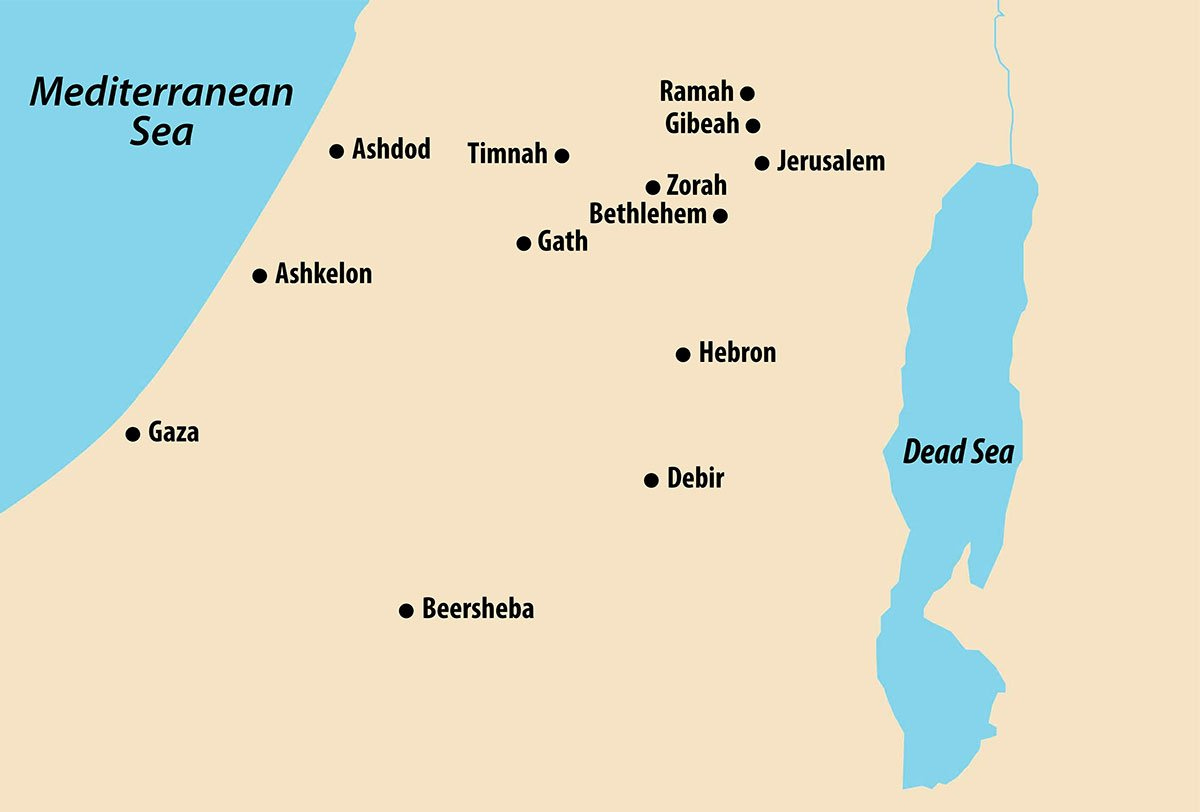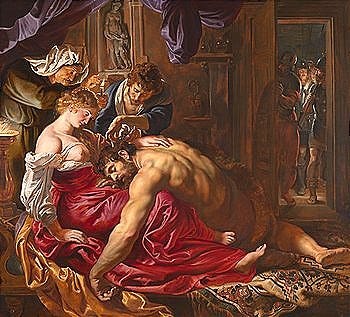This is part sixteen of my Judges study. Read the previous parts here and watch for part seventeen coming on April 16. Chapter 16 records the end of the story of Samson and his very problematic relationship with Delilah.
The final chapter of Samson’s story begins by recounting events that took place when Samson went to the Philistine city of Gaza and slept with a prostitute there. When the people of Gaza discovered where Samson was, they surrounded the city and waited for Samson at the gate, hoping to capture and kill him at dawn. However, Samson got up at midnight, pulled the city gates out of the ground, and carried them up to a mountain overlooking Hebron, thus thwarting the Philistines’ plans.
The trip from Gaza to Hebron, a leading city in Judah at this time, is 62.5 km long and is uphill the whole way.1 While carrying the heavy gate for such a long distance was certainly an impressive feat, it was completely unnecessary and served no purpose besides being something for Samson for Samson to brag about.2
After an unspecified amount of time, Samson fell in love with Delilah, a woman from the Sorek Valley, presumably a Philistine, though nowhere does the text state this.3 An important location, the Valley of Sorek marked the division between the coastal plain of the Philistines and the hill country of the Israelites.4 Notably, Delilah is the only woman named in the story of Samson and the only woman he loved.5 The Philistine leaders, evidently still seeking revenge, told Delilah to discover the secret to Samson’s supernatural strength, promising her 1100 pieces of silver from each of them if she succeeded. This would have amounted to 63.2 kg of silver in total, an enormous sum of money that shows how badly the Philistines wanted to capture Samson.6
Enticed by this offer, Delilah asked Samson for the secret of his strength and how someone could overpower him, who replied that he would lose his strength if he were tied up with seven fresh bowstrings that had never been dried. These bowstrings would have been made from the tendons of a sheep or cow and would have further violated Samson’s Nazirite vow of not touching dead bodies.7 It also should be noted that due to the Philistines wanting to discover the secret of Samson’s strength, he probably was not a big muscly dude as he is almost always portrayed as.8
After the Philistine leaders brought the bowstrings to Delilah, she tied Samson up in them as the Philistines waited in ambush. Delilah then called out to Samson, alerting him of the presence of the Philistines, after which Samson snapped the bowstrings he had been tied up in as easily as yarn touching fire. Upset by this, Delilah called out Samson for lying to her and again asked him how he could be defeated.
Samson answered for the second time, telling Delilah that he would lose his strength if he were tied up with new ropes that had never been used. So Delilah repeated the process from before of tying Samson up and telling him the Philistines were there to capture him. Again, Samson snapped the ropes easily, as though they were threads.
For the third time, Delilah asked Samson for the secret of his strength, and he replied that she should weave his seven braids of hair into the fabric on a loom. The Septuagint includes a small segment not found in the Hebrew that reads, “‘…and fasten them with a pin into the wall and I will become weak and be like any other man.’ And while he was sleeping, Delilah wove the seven braids on his head into the loom.” Delilah’s fastening the pin in Samson’s hair while he slept is similar to Jael’s driving a tent peg into the head of the sleeping Sisera, though in the former case, the man in danger is an Israelite rather than a Canaanite.9 After Delilah called out, Samson woke up and pulled out the pin that Delilah had used to fasten his hair. Based on descriptions from the passage, this was most likely a horizontal loom that was made by putting four stakes in the ground in a rectangular shape.10
By this point, Delilah was frustrated with Samson’s repeated lying and said that if he really loved her, he should tell her the truth. Day after day, she pleaded with him to tell her until he gave in and explained that his hair had never been cut and that he would become weakened if his hair was cut. Delilah summoned the Philistine leaders for the final time, who brought the silver with them. While Samson was sleeping, Delilah shaved his head, and his strength left him. Upon waking up, Samson thought he would be able to escape, but he was unable to do so.
The Philistines gouged out Samson’s eyes, put him in bronze shackles, and took him to Gaza to grind grain in prison. This would have been ultra humiliating for Samson, as grinding grain was considered to be a woman’s task.11 Then, the Philistines gathered to celebrate Samson's capture and worship their god, Dagon. When the people were in a good mood, they requested that Samson be brought out. So Samson was brought out and stood between the two pillars of the temple, entertaining the Philistines.
Dagon was a grain deity associated with the Philistines in the Bible.12 It was formerly thought that his name meant something like “fish god,” but this theory has been discounted and it is now believed that Dagon means “grain god.”13
The temple was full of people with many on the roof as well. Samson called out to the Lord, asking for his strength back one more time, as he wanted vengeance on the Philistines for gouging out his eyes. This prayer of his is clearly egotistical in nature, as it uses first-person pronouns five times.14 Even in his last moments, Samson’s primary concern is himself. Standing between the two pillars supporting the temple, Samson placed a hand on each one and pushed, requesting that he die with the Philistines. Then the temple collapsed, killing Samson and everyone else inside. More Philistines were killed by Samson in this event than the total number he had killed in his life.
Although there has not been any temple of Dagon discovered at Gaza, a temple from Tel Qasile was excavated and it was found that the roof was supported by two cedar pillars about three meters apart; this provides an example of what the Philistine temple to Dagon at Gaza may have been like.15 Samson’s brothers and the family of his father came to retrieve his body and buried him in the tomb of his father Manoah between Zorah and Eshtaol. He had judged Israel for twenty years.
And so, the story of the last judge in the book of Judges has come to a close. Samson was a man motivated only by selfish interests and easily manipulated by foreign women. He broke his Nazirite vow multiple times, committed numerous sinful acts without repentance, and never even managed to deliver Israel from the Philistines. Seemingly, the only thing he accomplished during his judgeship was killing a bunch of Philistines.16 In fact, it can be argued that Samson almost becomes a Philistine himself as he certainly did not live in the way that a faithful Israelite should have.
With that being said, Samson is in no way a good role model to follow! Rather, his story is a warning of what happens when one lives in disobedience to God.17 As a great quote reads, “It is truly amazing and ironic that this multi-fornicator, who delivered no one, is made to typify the Lord Jesus Christ, who gave his life that we might be delivered, really delivered, from the worst death, spiritual death!”18
We have gone through all the stories of the judges now, but there are still five more chapters in the book of Judges to go! I have what is hopefully an interesting post coming next week all about a super weird and messed-up story I wrote (and illustrated) in grade six… so stick around if you want me to embarrass myself on the internet.
BIBLIOGRAPHY
Block, Daniel I. “Judges.” In Joshua, Judges & Ruth, edited by John H. Walton, 198-451. Zondervan Illustrated Bible Backgrounds Commentary Series. Grand Rapids, MI: Zondervan, 2009.
Boda, Mark J. “Judges.” In Judges, Ruth, edited by Tremper Longman III and David E. Garland, 30-347. The Expositor’s Bible Commentary Series. Grand Rapids, MI: Zondervan, 2012.
Evans, Mary J. Judges and Ruth. Tyndale Old Testament Commentaries Series. Downers Grove, IL: InterVarsity Press, 2017.
McCann, J. Clinton. Judges. Interpretation: A Bible Commentary for Preaching and Teaching Series. Louisville, KY: John Knox Press, 2011.
Way, Kenneth C. Judges and Ruth. Teach the Text Commentary Series. Grand Rapids, MI: Baker Books, 2016.
Webb, Barry G. The Book of Judges. The New International Commentary on the Old Testament Series. Grand Rapids, MI: William B. Eerdmans Publishing Company, 2012.
Younger Jr., K. Lawson. Judges and Ruth. The NIV Application Commentary Series. Grand Rapids, MI: Zondervan, 2002.
Webb, The Book of Judges, 399.
Younger, Judges and Ruth, 303.
Way, Judges and Ruth, 200.
Webb, The Book of Judges, 401.
Younger, Judges and Ruth, 304.
Way, Judges and Ruth, 200.
Block, “Judges,” 363.
Way, Judges and Ruth, 201.
Boda, “Judges,” 272.
Younger, Judges and Ruth, 307.
Boda, “Judges,” 276.
Way, Judges and Ruth, 202.
Webb, The Book of Judges, 412.
Younger, Judges and Ruth, 311.
Block, “Judges,” 367.
Evans, Judges and Ruth, 161.
McCann, Judges, 118.
Younger, Judges and Ruth, 316.







Well written Rachel!